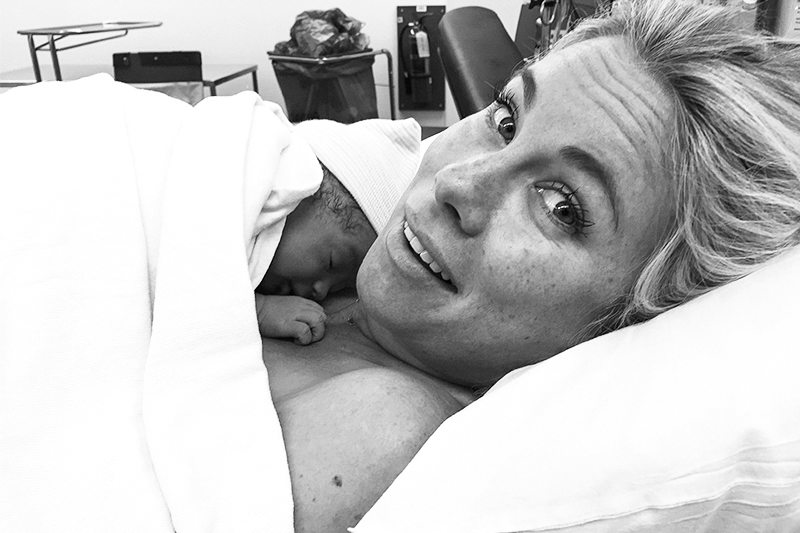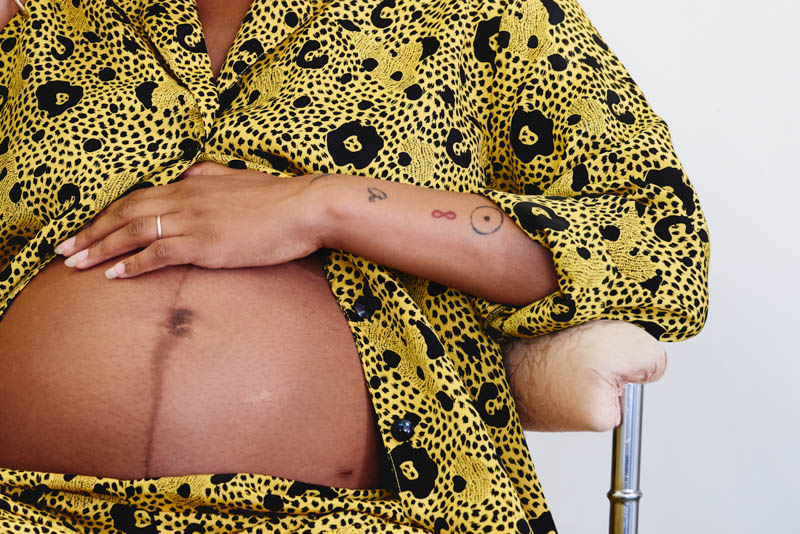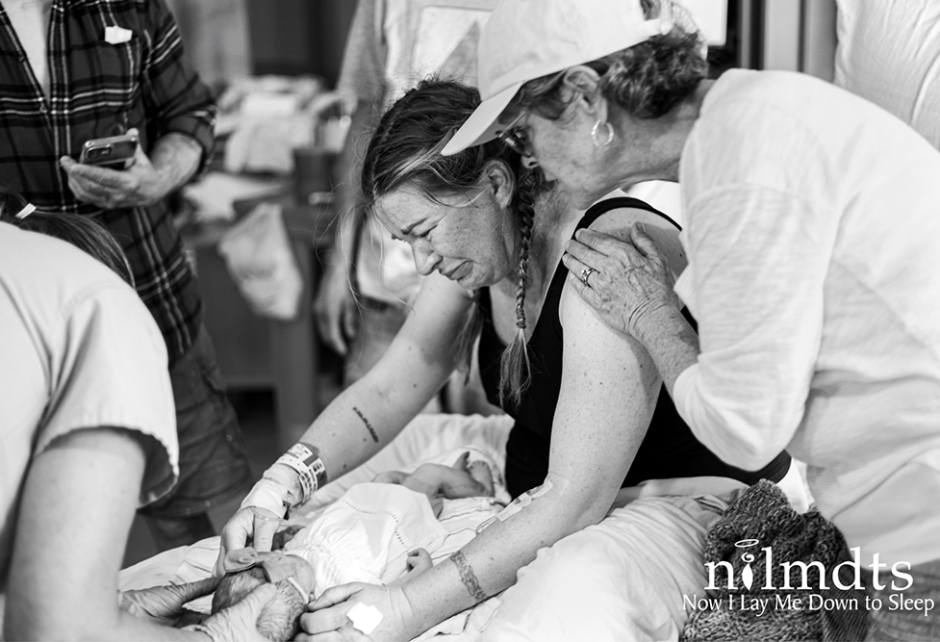
Mom Talk: A Breech Story
Written by Elspeth Keller
Photography by Photograph Courtesy Of Elspeth Keller
We’re back with another round of “Mom Talk”, where we invite some incredible mothers, from all walks of life, to share their personal experiences and journeys through motherhood, whether it be struggles, triumphs, or anything in-between—nothing’s off limits when it comes to topics. This week, Elspeth Keller is back and talking how she flipped her thinking when her baby wouldn’t turn. -JKM
I’m pregnant for the first time, and it just so happens that I’m working on a writing project with my husband Reid that revolves around the OB/GYN world. We have an option on a book that we want to base a TV series on; the plan is to take it to market after the baby is born. In the meantime, and, as a result, I’m doing copious research on the subject. I’m reading things like “serious neonatal morbidity” repeatedly. And, “Women are so worried, in fact, that there’s a new psychiatric diagnosis: tokophobia, the fear of giving birth.” And, best of all: “Through the gush of blood, he suctioned out her vagina, moving upstream in a circular motion, looking for any sign of whatever cervix she had left after the delivery and rupture.” Really encouraging stuff.
More than anything, I want to avoid a C-section. I’m watching documentaries like The Business of Being Born, which discusses the C-section rate being over 30% (the highest it’s ever been) and talks about the rush you feel from a normal birth, and how drugs or surgery can block that. While my street smarts are nil because this is my first pregnancy, I’m book smart about baby heart rate monitors and what percentage of the time guts are opened versus perineums torn. I have to know for my project. I wish I didn’t know for my life.
We interview doulas because I read an article on Huffington Post which reports that doulas reduce the odds of having a C-section by sixty percent. When we interview Carla, an ethereal yogi-doula, I ask if there is anything in between an epidural and going completely unmedicated. “Yes,” she smiles, pauses, and looks at us meaningfully, “Breath.” Umkay. The next doula we interview, Erica, gives me a much more scientific answer, listing the various levels of medication and what she recommends or discourages. She’s pragmatic and Earth Mother at once. She laughs at my jokes. I can imagine her in the labor room with us. She’s hired.
We blissfully soak up the childbirth education classes that are included in Erica’s package. We learn about all the signs that labor is beginning. We come to understand that waters breaking (and it is waters plural, who knew) is much less common than cinema suggests, perhaps because the other telltale signs are just a feeling inside the uterus (harder to film) or a dislodged mucus plug (grosser to film). We learn about the stages of labor and delivery, the hormones that come with them, and what my face is supposed to look like during each phase. We breathe and I roll over the inflatable exercise ball. One afternoon I get a free massage from my husband, while Erica watches and directs. It was my favorite day. Reid and I are taught to gaze into each other’s left eye for strength. It actually does make us feel strong, and then makes us cry.
As I read and learn, I see I have two choices: be terrified or be brave. So, I amp myself up and decide I want to feel it all. Adrenaline, endorphins, and oxytocin sound like an incredible cocktail. Oxytocin alone is often referred to as the “love hormone.” Present during sex, contractions, and breastfeeding, it literally makes you feel nurturing. I’d repeatedly heard you never knew you could love something so much from parents with children outside the womb, and this might explain why. I want none of it blocked or dulled, I want to give birth naturally, as my mother did with me. I talk with as many women as I can about their labor and delivery stories, cataloging the varied accounts of dilation and pushing. I sit in on a “Birth Story” circle, where pregnant women listen as new moms recount their birth tales over wild rice and mung beans. My favorite pregnancy guidebook is Expecting Better by economist Emily Oster, and my birth plan mimics hers almost to the letter. No epidural, doula present, no episiotomy, pitocin only after the baby is delivered (to avoid hemorrhaging), Gatorade mandatory.
But, how does that saying go? Mom’s make birth plans, babies laugh?
And then, at thirty-seven weeks, we meet with my OB/GYN, Dr. Aliabadi, for the eighth time during my pregnancy. She’s patient with us as we go over a list of questions that Erica helped us put together. We talk about how long she’ll let me go before inducing (41 weeks), what to do if my waters break (take a shower and come to the hospital), how late in the game I can eat (4cm). When I declare my intention to do it all without drugs, she seems like she’s trying to be neutral.
When we are done with our list of questions, Aliabadi pulls out the sonogram wand and I belly up to the bar. “Uh-oh,” she says, “bad baby.” There is a collective holding of breath; I can’t imagine why my doctor is disciplining my fetus. She reports the baby is breech, sitting up inside me as if lounging in a hammock and sipping a cocktail. Breech babies are almost always delivered via C-section.
I don’t cry until we get home, and then I sit in my office, stare out the window, feel grateful that the baby is okay, and cry anyway. I feel angry and gypped that I won’t get to do this powerful, universal, female thing. I had so thoroughly psyched myself up, this new development feels like the biggest let down.
Once I’ve pulled it together, I investigate ways to get the baby to turn. First I go to a chiropractor, Dr. Berlin, famous in L.A. for turning babies, and unforgettable because he’s so tall, wide, wears a yamaka, and quickly tells you how he suffers from face blindness. With huge hands, he does his signature chiropractic prenatal massage adjustment. I feel the baby move, but can’t tell in which direction. No stone unturned, I try a burning mugwort stick by my baby toes, as well as an acupuncturist, and the website spinningbabies.com. I crawl around on all fours and invert myself on an ironing board resting against the couch for twenty-minute increments. The last and most extreme approach is the external cephalic version (often referred to as “a version”), which is when a doctor forcibly turns the baby from the outside. When Aliabadi mentions it as an option, she follows with telling us about a friend who just did one that “ended in tragedy.” Which of course leads to an immediate “Nope!”
While I’m actively trying to get him to turn, I mentally begin to accept the possibility that he might not. I start talking to the women whose birth stories I’d skipped over because they were surgeries. I suddenly feel bad and C-sectionist as I realize that I never asked them any important questions. How was the procedure? The recovery? Cute scar? And then, everyone knows someone who was breech or had a breech baby or was breech themselves. The statistic is 4%, but anecdotally, it feels like 40. Two of Reid’s closest pals were breech. My cousin was breech. I discover even my best friend Shawn was breech. So, I get on the phone with Shawn’s mom, Stacy, who is the complete blueprint for Shawn, down to the exact laugh, but slightly taller and with more life experience. It’s like talking to my best friend in the future. Stacy tells me that she had a “Cinderella C-section experience.” She describes Iron Maiden playing on headphones and how her husband arrived from his construction job, still sweaty and saw dusty under his scrubs. It was so delightful, she did it again with Shawn’s younger brother a couple years later.
But, perhaps the most important piece of advice comes from a total stranger and via text. A friend’s friend who also had a breech situation recommends all the things I’ve tried, from acupuncture to ironing board. And then, she writes something else: “Once the baby comes, the birth isn’t that big of a deal. I was so stressed out about how the birth would go, but it was nothing compared to how unprepared I was for having a new baby. The birth just doesn’t really matter.”
Oh.
At thirty-eight weeks, we go back to Aliabadi’s office to find out that, despite the efforts, we are still part of the 4%. But, I feel better about it now. I tell myself that we’ve done our best, perhaps the incredible love that everyone is talking about will just take a little longer to show up, and I psych myself up—to be patient.
At thirty-nine weeks, at 5 a.m., Erica joins us at the hospital with eucalyptus oil and a big I-got-up-at-four-am-too smile. She rubs my feet, while they insert the IV and then waves as they wheel me off to the operating room. Reid paces outside the OR as my epidural is inserted and they ask me if I have a preference on a Pandora station. As I answer Van Morrison, my legs begin to lose feeling and they let Reid into the room.
Classic, soulful music provides a backdrop for what feels like a birth in outerspace. The huge circular lights, like massive versions of what they point at you at the dentist, shine down on me in this immaculate room full of masked people in scrubs, all working like robots. When Aliabadi enters, her rockstar status heightens the room’s energy. The robots work faster. Aliabadi carefully draws a smile on my pubic area. She says it’s go time. I feel pressure, like an overweight cat is kneading my abdomen, as Reid looks into my left eye and tells me that I’m amazing. It’s nice to still get credit even in this less-sweaty birth scenario. We’re interrupted when Reid is told he can stand and look over the draped blue sheet. He watches the baby come out ass first, which is announced in a more medical way, followed by “feet out…look at those feet!” He’s got big feet, all the robots agree, chuckling. I’m told arms follow, and then the head, and I hear Reid make a sharp noise of delight that I’ve never heard him make before. The baby and Reid are whisked off for measuring and weighing and cord cutting. I haven’t seen my son. I listen to more noises of delight coming from Reid mixed with cries coming from the baby. I gather I’m being sewn up, but feel nothing. The space lights are my main companion as I wait and listen, numb and alone.
After what feels like too long, Reid comes back around the sheet holding a tightly swaddled newborn in a hat. He’s put in my arms and at first sight of his tiny smushed face, my numb body is filled with an exploding heart. I can’t believe he’s mine. I’m astounded, humbled, love-struck. A video that a nurse takes features me earnestly asking “ARE YOU KIDDING ME?!” over and over and over again.
The first day in the hospital, I stare at my baby, taking in every inch of his body and falling in love with the individual pieces. There is a similar version of this process when falling in love romantically. I remember in the beginning with Reid, the sheer delight in discovering the freckle on his lip. There’s a freckle on his lip! Be still my heart! It looks like he was eating a cookie and a piece of a chocolate chip got stuck there! Ah, this glorious world is mine! So it is with newborn Conrad, but his freckle is a thumbprint-sized blonde spot on the top of his otherwise brunette head. Reid and I decide that our genes were fighting, his won, but gave mine a tiny headquarters, just to be neighborly. It takes all of my power to refrain from texting my childless girlfriends “STOP WHAT YOU ARE DOING AND HAVE A CHILD IMMEDIATELY. WORRY NOT ABOUT CAREER NOR RELATIONSHIP, ANY SPERM WILL DO. JUST TRUST ME.” It’s the most powerful, universal, female feeling.
Nearly three years later, I am pregnant for a second time and I’ve switched to Dr. Cousineau, because she’s open to VBACs (vaginal birth after C-section) and I want that option. At our thirty-seven-week appointment, Conrad’s younger brother is politely head down. So, this time both the baby and the doctor have left it up to me.
And then, we find out that the baby is measuring large. So, without much hemming or hawing, like Stacy, I chose to have another C-section. It went so well the first time. I know I don’t need labor or the love hormone to feel like I never knew I could love something so much. I’ve put my inverted version of tokophobia aside. And, as a mother of one, I’m hip to the real challenge being after the baby is born. Because once the baby has arrived safely, I’m with that stranger’s text message: The birth just doesn’t really matter as much. All is eclipsed by the cosmic love for the newest, tiniest human in the room.
Are you a mom with something to say? Send us an email to be considered for our “Mom Talk” column.
Share this story



